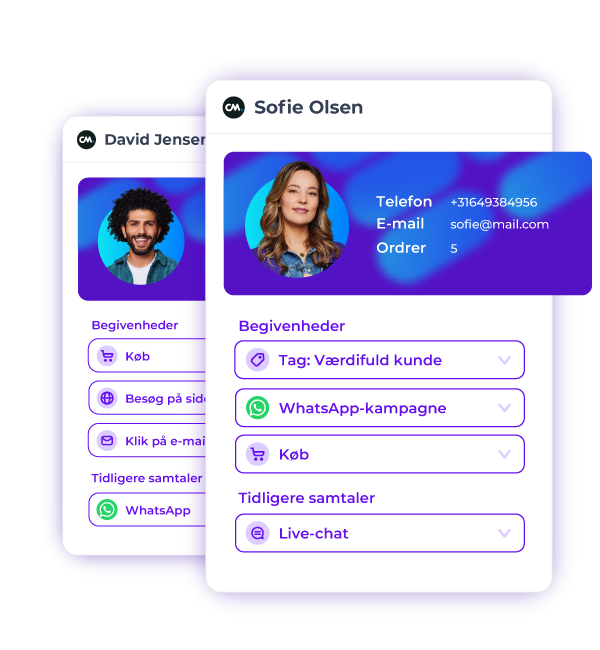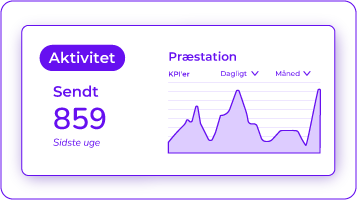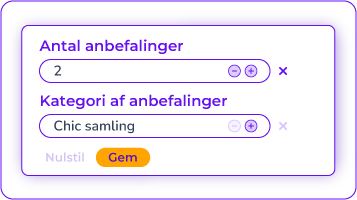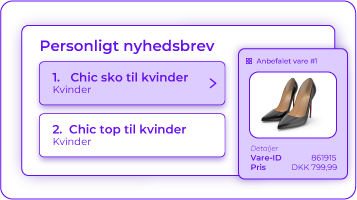
Øg relevansen og indtjeningen med personalisering ved hvert kontaktpunkt
Konsolider nemt eksisterende dataplatforme og fjern overflødige værktøjer.
Giv medarbejderne mulighed for at få adgang til og forstå kundedata på ét sted.
Udnyt dine egne datakilder til at opbygge en omfattende forståelse af hver enkelt kunde og mindsk afhængigheden af tredjepartscookies. Vores kundedataplatform forener data på tværs af alle berøringspunkter til 360-graders kundeprofiler i realtid, så du kan pleje stærke relationer og øge omsætningen.
Følg med i de besøgendes browsingmønstre, og flet med den relevante profil, når det er muligt.
Integrer førstepartsdata, uanset hvor de er gemt, og undgå afhængighed af cookies.
Identificer og flet data fra den samme person nøjagtigt til 360° kundeprofiler.
Forbedre kundeprofiler med AI-drevne anbefalinger, som f.eks. forudsigelse af adfærd, så kundeservice og marketing kan levere virkelig personlige 1:1-interaktioner.
Anmod om en demoForbind eksisterende datakilder, og lad AI'en lære fra starten og løbende med hver eneste interaktion.
Tilfør algoritmerne din egen virksomhedsspecifikke kontekst, og juster om nødvendigt for at sikre præcise og relevante forudsigelser.
Få gennemsigtighed og indsigt i, hvorfor visse AI-drevne anbefalinger er blevet foreslået.

Identificer og segmenter nemt kundeprofiler baseret på historiske interaktioner og adfærd i realtid. Med blot nogle få klik kan du nemt oprette datadrevne målgrupper til hver kampagne.
Opret, automatiser og aktiver kampagner baseret på kundeadfærd og triggere for at nå dine kunder på det rigtige tidspunkt, med de rigtige oplysninger og på den rigtige kanal.
Vores Customer Data Platform integreres problemfrit med vores service- og marketingværktøjer for at skabe en samlet kundeoplevelse og forene data på tværs af afdelinger. Den forbindes ubesværet med vores Mobile Marketing Cloud, AI Decisioning Engine, og Mobile Service Cloud.
Vores Engagement Platform forbinder vores Customer Data Platform med marketing for at sikre, at alle data er tilgængelige for at levere personaliserede kampagner og skræddersyet indhold.
Vores Engagement Platform integrerer vores Customer Data Platform med kundeservice og giver alle marketing- og servicedata lige ved siden af samtalen, alt sammen på én skærm.
Vores Engagement Platform forbinder kundedata med vores chatbots for at sikre personaliserede samtaler, og omvendt trækker vi data fra chatbots til Customer Data Platform.
Når vi opbygger e-mailkampagner, kan vi få adgang til realtidsdata direkte via CM.com-platformen. Vi kan derefter undersøge disse data for at finde ud af, hvem vi vil tale med, oprette et undersegment og skræddersy vores kommunikation til den gruppe.
Iain Starkey, Marketing Manager
Vi vil gerne bruge CM.com's platform så meget som muligt, fordi det giver os mere information om, hvad vores støtter og de mennesker, der besøger Sophia Gardens, ønsker, og så kan vi indrette deres oplevelse derefter.
Ed Rice, Head of Commercial
Med alle de lagrede oplysninger i Customer Data Platform blev der skabt det mest komplette 360-graders billede af fansen. Baseret på disse data gav Mobile Marketing Cloud det hollandske Grand Prix mulighed for at kommunikere med alle fans på en personlig og praktisk måde.
Teun Verheij, Head of Marketing Communications

En CDP eller Customer Data Platform er software, der indsamler kundernes berøringspunkter og interaktioner med dit produkt eller din service fra forskellige kanaler og kilder. Den samler alle disse data fra flere kilder for at skabe en samlet profil af hver kunde.
Læs mereCookieless dataindsamling indsamler brugerdata og -indsigt uden brug af webstedscookies (datasporere, der indeholder personlige identifikatorer), enten fordi brugeren afviser dem, eller fordi de ikke er tilladt. Denne metode er i vækst på grund af flere sporingsrestriktioner og regler om privatlivets fred.
Læs mereFørstepartsdata er kundedata, der er indsamlet med samtykke og ejes direkte af din virksomhed (den dataansvarlige). Det er en værdifuld kilde til kundeindsigt i en tid med databeskyttelse, da regler og sikkerhedsforanstaltninger nu gør andre typer data mindre sikre, nøjagtige og pålidelige.
Læs mereSporing på klientsiden og serversiden er to måder at indsamle målgruppedata på. Med sporing på klientsiden sender brugerens browser (klient) data til sporingsplatformens server. Sporing på serversiden sender først brugerdataene til din hjemmesides server, før de overføres til sporingsplatformen.
Læs mereSom marketingmedarbejder har du uden tvivl hørt om begrebet Customer Data Platform (CDP). Men hvad er det, og hvad går du glip af, hvis du ikke har en? I denne guide kan du læse alt, hvad du behøver at vide for at samle alle dine online og offline kundedata og skabe marketingkampagner, der giver kunderne en wow-følelse.
I dag er det en helt ny kunde, der styrer markedet. Og fra produkt til service til salg forventer de, at deres oplevelse skal være så personlig som overhovedet muligt.
Select a region to show relevant information. This may change the language.








